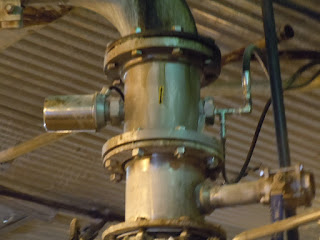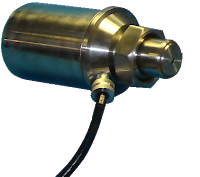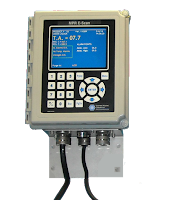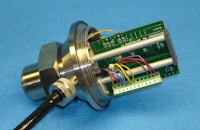This blog focuses on industrial, inline process refractometers and their use in industrial applications. Refractometry is used to measure the refractive index of a substance in order to determine its composition or purity. Posts include information on theory, construction, installation, new products and new markets.
Electron Machine Corporation | Umatilla, FL | PHONE: 352-669-3101 | ElectronMachine.com
Video: Applying Refractometers to the On-line Measurement of Green Liquor Density
A presentation to the Western Canada Black Liquor Recovery Boiler Advisory Committee (BLRBAC) by Electron Machine Corporation. The presentation slides were made in to this video for viewing on YouTube.
What is the BLRBAC?
The BLRBAC stands for Black Liquor Recovery Boiler Advisory Committee. It was formed in 1961 as a non-profit trade association dedicated to improved safety of chemical recovery boilers, and their auxiliaries, through the interchange of technical knowledge, experience, and data on past and any future recovery boiler incidents.
It's formation stemmed from an alarming number of explosions, injuries, and deaths involving Black Liquor Recovery Boilers. Industry professionals from insurance companies, paper companies, and boiler companies agreed to create the BLRBAC for the purpose of generating safety procedures and guidelines that govern the operation of Black Liquor Recovery Boilers.
The BLRBAC has a number of active sub-committees that are constantly reviewing and updating their safety guidelines to reflect current technology and knowledge.
The Black Liquor Recovery Boiler Advisory Committee meets twice a year in Atlanta GA, usually the first week in April and October.
For more information about the BLRBAC, visit http://www.blrbac.org.
It's formation stemmed from an alarming number of explosions, injuries, and deaths involving Black Liquor Recovery Boilers. Industry professionals from insurance companies, paper companies, and boiler companies agreed to create the BLRBAC for the purpose of generating safety procedures and guidelines that govern the operation of Black Liquor Recovery Boilers.
The BLRBAC has a number of active sub-committees that are constantly reviewing and updating their safety guidelines to reflect current technology and knowledge.
The Black Liquor Recovery Boiler Advisory Committee meets twice a year in Atlanta GA, usually the first week in April and October.
For more information about the BLRBAC, visit http://www.blrbac.org.
Important Process Instrumentation Terminology
In describing the characteristics and operation of process control instruments (such as process refractometers), it is very important to understand some common terms used in the industry. The definitions of some of the more common terms are provided below:
Accuracy: The closeness of an indicator or reading of a measurement device to the actual value of the quantity being measured; usually expressed as ± percent of the full scale output or reading.
Drift: The change in output or set point value over long periods of time due to such factors as temperature, voltage, and time.
Hysteresis: The difference in output after a full cycle in which the input value approaches the reference point (conditions) with increasing, then decreasing values or vice versa; it is measured by decreasing the input to one extreme (minimum or maximum value), then to the other extreme, then returning the input to the reference (starting) value.
Linearity: How closely the output of a sensor approximates a straight line when the applied input is linear.
Noise: An unwanted electrical interference on signal wires.
Nonlinearity: The difference between the actual deflection curve of a unit and a straight line drawn between the upper and lower range terminal values of the deflection, expressed as a percentage of full range deflection.
Precision: The degree of agreement between a number of independent observations of the same physical quantity obtained under the same conditions.
Repeatability: The ability of a sensor to reproduce output readings when the same input value is applied to it consecutively under the same conditions.
Resolution: The smallest detectable increment of measurement.
Sensitivity: The minimum change in input signal to which an instrument can respond.
Stability: The ability of an instrument to provide consistent output over an extended
period during which a constant input is applied.
Zero balance: The ability of the transducer to output a value of zero at the electronic null
point.
Accuracy: The closeness of an indicator or reading of a measurement device to the actual value of the quantity being measured; usually expressed as ± percent of the full scale output or reading.
Drift: The change in output or set point value over long periods of time due to such factors as temperature, voltage, and time.
Hysteresis: The difference in output after a full cycle in which the input value approaches the reference point (conditions) with increasing, then decreasing values or vice versa; it is measured by decreasing the input to one extreme (minimum or maximum value), then to the other extreme, then returning the input to the reference (starting) value.
Linearity: How closely the output of a sensor approximates a straight line when the applied input is linear.
Noise: An unwanted electrical interference on signal wires.
Nonlinearity: The difference between the actual deflection curve of a unit and a straight line drawn between the upper and lower range terminal values of the deflection, expressed as a percentage of full range deflection.
Precision: The degree of agreement between a number of independent observations of the same physical quantity obtained under the same conditions.
Repeatability: The ability of a sensor to reproduce output readings when the same input value is applied to it consecutively under the same conditions.
Resolution: The smallest detectable increment of measurement.
Sensitivity: The minimum change in input signal to which an instrument can respond.
Stability: The ability of an instrument to provide consistent output over an extended
period during which a constant input is applied.
Zero balance: The ability of the transducer to output a value of zero at the electronic null
point.
Process Refractometers Built to Handle the Toughest Conditions
Users agree. Electron Machine builds the most rugged process refractometer available for the pulp and paper, food and beverage, and chemical industries.
https://electronmachine.com
352-669-3101
https://electronmachine.com
352-669-3101
Process Refractometers for Food and Pharmaceutical Processing
Process refractometers provide the analysis to quickly, reliably, and very accurately identify a sample and determine it's concentration and purity levels. They measure the refractive index and temperature of flowing liquids, and apply mathematical functions to determine the concentration of dissolved solids.
Process refractometers are particularly useful in the food and pharmaceutical industries where they are used to optimize production processes, control quality, and ensure consistency and purity.
In commercial food applications such as juice production or tomato processing, refractometers are used to measure degrees Brix. The Brix scale relates refractive index to sugar concentration, and is a key way to maintain consistency. For example, process refractometers are used for the concentration process of fruit juices. The concentration process is normally achieved by removing water through evaporation, and by measuring Brix, the evaporation process can be controlled and related to the desired juice concentration.
In the pharmaceutical industry, process refractometers are used to monitor and control concentration levels during supersaturation, a critical process in crystallization. Crystallization is key to the purification of solids in pharmaceutical production. A high degree of measurement accuracy and reliability provided by the process refractometer ensures precise monitoring and control and a pure product.
There are many other industrial applications for process refractometers, almost all sharing the need for accurate solids content measurement.
For more information about process refractometers, contact Electron Machine. Visit them at https://electronmachine.com or call 352-669-3101.
Process refractometers are particularly useful in the food and pharmaceutical industries where they are used to optimize production processes, control quality, and ensure consistency and purity.
In commercial food applications such as juice production or tomato processing, refractometers are used to measure degrees Brix. The Brix scale relates refractive index to sugar concentration, and is a key way to maintain consistency. For example, process refractometers are used for the concentration process of fruit juices. The concentration process is normally achieved by removing water through evaporation, and by measuring Brix, the evaporation process can be controlled and related to the desired juice concentration.
In the pharmaceutical industry, process refractometers are used to monitor and control concentration levels during supersaturation, a critical process in crystallization. Crystallization is key to the purification of solids in pharmaceutical production. A high degree of measurement accuracy and reliability provided by the process refractometer ensures precise monitoring and control and a pure product.
There are many other industrial applications for process refractometers, almost all sharing the need for accurate solids content measurement.
For more information about process refractometers, contact Electron Machine. Visit them at https://electronmachine.com or call 352-669-3101.
Refractometers for Industry
Industrial process refractometers provide safe, reliable, and accurate process measurement for the pulp and paper industry, the food and beverage industry, and the chemical industry. Electron Machine manufactures the world's most rugged refractometers and has thousands of refractometers controlling processes, improving quality, and saving cost in these industries around the world.
In-Line Process Refractometers
 |
| In-line Process refractometer sensor in spool-piece. |
In-line Process refractometers save labor costs, streamline the manufacturing process, and improve quality by detecting inconsistencies in a product early in the production phase.
 |
| Process refractometer sensor. |
The control module includes programming for a wide variety of commonly required features, capabilities, and options that can be adapted to a customer’s requirements. This microprocessor control also allows for custom programming for specialized needs.
 |
| Process refractometer control module. |
The sensor can be supplied with a multitude of mounting and cleaning options. Cleaning options include hand cleaning systems, high pressure cleaning systems, and steam cleaning systems. Mounting adapter options include lined adapters, spool-piece adapters, sanitary connection adapters, and weld-in adapters.
Not to be confused with their distant relatives - the handheld digital or analog laboratory refractometer - today's rugged, industrial in-line process refractometers provides continuous process management for large-scale facilities giving them the ability to increase product yield, maintain consistency, and eliminate waste.
Subscribe to:
Posts (Atom)



